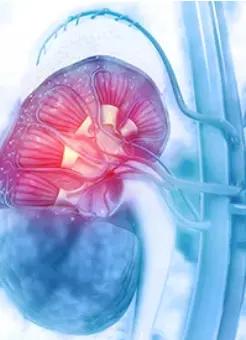News
Article
Supplements and Featured Publications
Ipilimumab Plus Nivolumab Increases 12-Month OS Rate vs SOC in nccRCC
Ipilimumab given in combination with nivolumab met the primary end point of 12-month OS rate vs SOC in patients with nccRCC in the SUNNIFORECAST trial.
Renal Cell Carcinoma | Image Credit:
© Crystal light - stock.adobe.com

Ipilimumab (Yervoy) plus nivolumab (Opdivo) significantly improved the 12-month overall survival (OS) rate vs standard-of-care (SOC) therapies in patients with non-clear cell renal cell carcinoma (nccRCC), meeting the primary end point of the phase 2 SUNNIFORECAST trial (NCT03075423), according to data presented during the 2024 ESMO Congress.
At a median follow-up of 24.3 months (range, 0.5-70.2), the 12-month OS rate was 86.9% (95% CI, 80.24%-91.46) among patients who received ipilimumab in combination with nivolumab (n = 157) vs 76.8% (95% CI, 68.62%-83.09%) among those treated with SOC (n = 152; P = .0141). The 6-month OS rates were 94.7% (95% CI, 89.72%-97.32%) vs 90.0% (95% CI, 83.75%-93.98%), respectively (P = .067) and the 18-month rates were 76.6% (95% CI, 68.69%-82.79%) vs 69.1% (95% CI, 60.25%-76.34%), respectively (P = .084). The median OS was 42.4 months (95% CI, 35.24-55.54) in the doublet arm compared with 33.9 months (95% CI, 25.52-not estimable) in the SOC arm (P = .292).
“A significant difference [in 12-month OS rate was observed] in favor of the combination arm,” Lothar Bergmann, MD, the deputy medical director in the Department of Internal Medicine at J.W. Goethe University in Frankfurt, Germany, said during the presentation. “The SOC for most patients [in the study] was TKI monotherapy and only 17% of patients received a TKI/IO combination in this group.”
SUNNIFORECAST Study Design
SUNNIFORECAST enrolled patients with metastatic or locally advanced nccRCC, including those with papillary, chromophobe, collecting duct carcinoma, renal medullary carcinoma, sarcomatoid, or unclassified disease subtypes. To be eligible for the study, patients could not have received prior systemic therapy for RCC or have active central nervous system metastases. Patients must have had measurable disease per RECIST 1.1 criteria and a Karnofsky performance status of at least 70%. Stratification was done by histology (papillary vs non-papillary) and IMDC score.
Patients were randomly assigned 1:1 to receive SOC agents or intravenous nivolumab 3 mg/kg plus ipilimumab 1 mg/kg every 3 weeks for 4 cycles followed by nivolumab 240 mg flat every 2 weeks or 480 mg flat every 4 weeks. Treatment in both arms continued until disease progression, unacceptable toxicity, or patient withdrawal. Treatment beyond disease progression was permitted under protocol-defined circumstances.
The primary end point was 12-month OS rate. Key secondary end points included OS, 6- and 12-month OS rates, progression-free survival, objective response rate, time to progression, safety, and quality of life.
The baseline characteristics were generally well balanced between the combination and SOC arms; the median patient ages were 61.4 years (range, 18.8-81.8) vs 64.0 years (range, 19.4-86.2), respectively. In total, patients (n = 309) in the study were male (70.9%), had a Karnofsky performance score of 100% (52.4%), had IMDC intermediate risk disease (51.8%), and underwent prior surgery (76.7%). Patients had sites of metastasis including the lungs (22.0%), liver (10.1%), bone (5.1%), lymph nodes (30.8%), and other (20.3%). The median time since initial diagnosis among all patients enrolled was 30.9 months (range, 1.3-1416.6).
Histological subtypes in the combination and SOC arms consisted of papillary RCC (56.7% vs 58.6%), chromophobe RCC (17.8% vs 21.2%), renal medullary carcinoma (0.0% vs 2.0%), translocation RCC (7.6% vs 3.3%), tubulocystic RCC (1.9% vs 0.0%), mucinous tubular and spindle cell carcinoma (0.6% vs 0.0%), sarcomatoid (5.1% vs 3.9%), Ductus Bellini carcinoma (0.0% vs 2.0%), and others (7.0% vs 6.6%).
Additional Findings fromSUNNIFORECAST
In terms of PFS, the median value in the combination arm was 5.52 months (range, 4.30-8.23) vs 5.65 months (range, 5.49-8.46) in the SOC arm (HR, 0.99; 95% CI, 0.76-1.18). The respective ORRs were 32.8%, with an 8.0% complete response (CR) rate, vs 19.6%, with a 1.6% CR rate, (P = .001). The ORR was higher with the combination vs SOC in patients with papillary (29.2% vs 21.0%), non-papillary (37.7% vs 18.2%), and chromophobe (25.9% vs 11.1%) histologies, respectively.
Notably, the HR for OS favored the combination arm among patients with a PD-L1 combined positive score (CPS) of at least 1% (HR, 0.56; 95% CI, 0.33-0.95; P = .031) but did not favor this arm among patients with patients who had a PD-L1 CPS of less than 1% (HR, 1.40; 95% CI, 0.79-2.46; P = .244).
Regarding safety, the most common any-grade adverse effects (AEs) in the combination and SOC arms included skin reactions (48.4% vs 74.2%), fatigue (42.9% vs 63.7%), diarrhea (21.0% vs 45.1%), pruritus (25.0% vs 2.8%), and nausea (20.6% vs 31.5%). The most common grade 3 or 4 AEs included increased alanine aminotransferase levels (5.7% vs 0.0%), fatigue (3.8% vs 8.4%), and diarrhea (3.2% vs 4.9%). Rates of any-grade AEs were generally higher in the SOC arm vs combination arm.
Patients in the nivolumab plus ipilimumab arm went on to receive subsequent second (63.7%), third (28.7%), and fourth (11.5%) lines of therapy. Patients went on to receive these lines of therapy at rates of 55.9%, 13.2%, and 9.2%, respectively, in the SOC arm.
“This is the first prospective randomized trial which compared dual checkpoint inhibitor combination therapy with the actual SOC in nccRCC,” Bergmann noted in conclusion. “The randomized SUNNIFORECAST trial underlines a relevant clinical benefit of the combination [of ipilimumab and nivolumab] in nccRCC and may be a new standard in these entities. Further data in the study of these rare diseases are needed in the future.”
Reference
Bergmann L, Ahrens M, Albiges L, et al. Prospective randomised phase-II trial of ipilimumab/nivolumab versus standard of care in non-clear cell renal cell cancer: Results of the SUNNIFORECAST trial. Presented at: 2024 ESMO Congress; September 13-17, 2024; Barcelona, Spain. Abstract LBA75.










